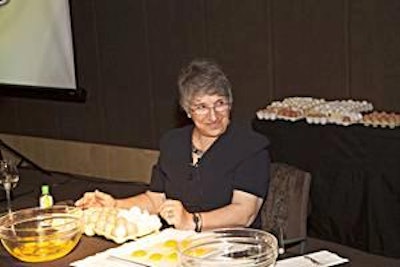
A workshop offering a new way of looking at eggshell quality took place in Spain in March. Headed by Professor Sally Solomon, consultant on egg quality and emeritus professor at the University of Glasgow Veterinary School, UK, the event took participants on a journey from ovulation to oviposition, with detours through disease, the environment and nutrition. Through specific cases, the roles played by these variables in influencing shell quality were examined.
Solomon explained that to understand why an egg has cracked or acquired textural changes on its shell requires, one needs to understand normal shell formation. Also required is an understanding of the roles played by the egg white and the paired shell membranes in the provision of a physically stable and chemically functional base, which the first salts to come out of the supersaturated solution of calcium will precipitate onto.
Phases
Participants were introduced to the concept of phases of mineralization and the role played by the organic matrix in the creation of the diverse layers from the true or calcified aspect of the shell.
During the initial slow phase, calcium carbonate deposits onto nucleation sites on the outer shell membrane giving rise to the basal layer of the shell. Thereafter, the process enters the fast phase, during which the protein composition of the matrix changes and the palisade layer is formed. An increase in the concentration of phosphorous brings about the termination of calcification.
This basic information applies to both the table egg and the hatching egg in terms of the requirement for robustness and the ability to inhibit bacterial ingress. But in its capacity as an embryonic chamber, the eggshell is required to do more. In its construction, it must afford the embryo the opportunity to withdraw calcium from its basal layer while the pore system facilitates water loss and gas exchange.
Show and tell
Attendees at the Alltech-sponsored workshop brought with them eggs that had caused concern, and these were compared with images of normal shells. Blood spots, meat spots, wrinkled shells and rough textured shells were discussed with reference to the limitations of technology in their identification and with regard to their etiology.
The effects of the ubiquitous stress factor on the morphology, and therefore the function of the reproductive tract, introduced the audience to the concept of epithelial breakdown as a causative factor in the production of second quality eggs. Specific staining techniques were used to demonstrate changes in the chemical composition of the oviduct, also affording an explanation for changes in the mineralization process.
While programmed cell death is a feature of normal development, the disappearance of patches of surface epithelium observed in the oviducts of birds exposed to environmental stress and disease can in part be explained by the poor adaptive capacity of some cells to activate a protective response. Cell death follows, and in the chicken, the brown meat spots associated with the egg white are evidence of such a process.
Few of the eggs examined in the workshop fell into the poor quality category; nevertheless, the practical session encouraged communication between participants and generated numerous questions.
The workshop included a session on those factors that enable a bird to maintain good shell quality in the face of age and a variety of external environmental insults, including disease.
The consumer measures egg quality visually, so egg size, shell color (particularly in the brown egg market) and shell texture are all used to encourage selection. The course provided an overview of those downgrades which rarely reach the marketplace, highlighting the role played by stress in the production of splashed and rough eggs and the effects of egg retention on their formation.
Particular attention was given to a transient change in stocking density which can occur when, in a cage system, a bird is found on the floor and placed at random in another cage. Under experimental conditions, this event caused egg retention in addition to major changes in the structure and function of the oviduct. The maintenance of good shell quality is multifaceted, and so, in addition to providing the bird with a diet which meets both bone and shell demands for calcium, it must stimulate gut health.
Of prime importance in the rearing of all livestock is health status. The increasing use of organically bound minerals is cited in the literature as an environmentally compatible means of improving the antioxidant status of the bird and enhancing its immune system.

















